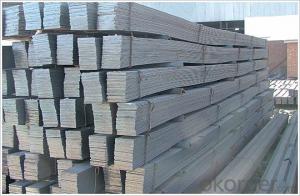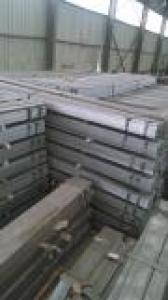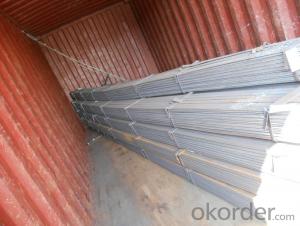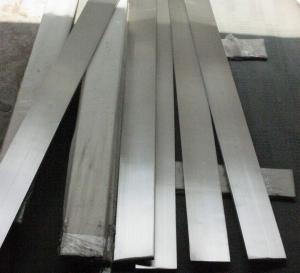Good Quality Flat Steel
- Loading Port:
- China Main Port
- Payment Terms:
- TT OR LC
- Min Order Qty:
- -
- Supply Capability:
- -
OKorder Service Pledge
OKorder Financial Service
You Might Also Like
1) Material: steel
2) Grade: 304, 304L, 316, 316L, 310S, 904L, 2205, B2, C22, 625, etc.
3) Shape: Flat
4) Surface: Black, Hairline, Bright, Polished
5) Finish: Cold drawn, Hot rolled
6) Size:
a) Thickness: 2-20mm
b) Width: 15-200mm
7) Length: 1000mm-12000mm
8) Application: Petroleum & chemical industries, construction field, machinery and hardware fields, food processing and medical industry, high or low temperature resistant, electricity industries, etc.
9) Packing: Standard export packages, custom suffocating free.
10) Min order: 1 ton
11) Origin: China (Mainland)
12) Note: Stainless steel bars/rods can be made according to the customers' requirements.
| Material | 201 | 202 | 304 | 316 | 430 |
C | ≤ 0.15 | ≤ 0.15 | ≤ 0.08 | ≤ 0.08 | ≤ 0.12 | |
Si | ≤ 1.00 | ≤ 1.00 | ≤ 1.00 | ≤ 1.00 | ≤ 1.00 | |
Mn | 5.5-7.5 | 7.5-10 | ≤ 2.00 | ≤ 2.00 | ≤ 1.00 | |
P | ≤ 0.06 | ≤ 0.06 | ≤ 0.045 | ≤ 0.045 | ≤ 0.040 | |
S | ≤ 0.03 | ≤ 0.03 | ≤ 0.030 | ≤ 0.030 | ≤ 0.030 | |
Cr | 16-18 | 17-19 | 18-20 | 16-18 | 16-18 | |
Ni | 3.5-5.5 | 4-6 | 8-10.5 | 10-14 |
| |
Mo |
|
|
| 2.0-3.0 |
| |
| Material Item | 201 | 202 | 304 | 316 | |
Tensile Strength | ≥ 535 | ≥ 520 | ≥ 520 | ≥ 520 | ||
Yield Strength | ≥ 245 | ≥ 205 | ≥ 205 | ≥ 205 | ||
Extension | ≥ 30% | ≥ 30% | ≥ 35% | ≥ 35% | ||
Hardness (HV) | < 253 | < 253 | < 200 | < 200 | ||
- Q:Can steel flat bars be used in the manufacturing of agricultural machinery?
- Yes, steel flat bars can be used in the manufacturing of agricultural machinery. Steel flat bars are versatile and durable, making them suitable for various applications in the agricultural industry. They can be used to construct frames, supports, brackets, and other structural components of agricultural machinery such as tractors, combines, tillers, and harvesters. The high strength and rigidity of steel flat bars ensure the durability and longevity of the machinery, even in harsh agricultural environments. Additionally, steel flat bars can be easily welded, bent, and shaped to meet specific design requirements, making them a preferred choice in agricultural machinery manufacturing.
- Q:How do steel flat bars compare to carbon fiber flat bars?
- Steel flat bars and carbon fiber flat bars have distinct differences in terms of material properties and applications. Steel flat bars are known for their durability and strength, making them suitable for heavy-duty applications where high load-bearing capacity is required. They provide excellent resistance to impact, bending, and deformation, making them ideal for use in construction, manufacturing, and automotive industries. Steel flat bars are also more cost-effective than carbon fiber flat bars. On the other hand, carbon fiber flat bars offer exceptional strength-to-weight ratio and are much lighter than steel flat bars. This makes them advantageous in applications that prioritize weight reduction, such as aerospace, sports equipment, and automotive industries. Carbon fiber flat bars also exhibit excellent resistance to corrosion and fatigue, providing enhanced longevity compared to steel flat bars. In summary, steel flat bars are favored for their strength, durability, and cost-effectiveness, while carbon fiber flat bars excel in terms of lightweight design, high strength-to-weight ratio, and superior corrosion resistance. The choice between the two depends on specific requirements, intended application, and budget constraints.
- Q:What are the different heat treatment processes for steel flat bars?
- There are several heat treatment processes for steel flat bars, including annealing, quenching and tempering, normalizing, and hardening. Annealing involves heating the steel to a specific temperature and then slowly cooling it to improve its ductility and reduce internal stresses. Quenching and tempering involves heating the steel to a high temperature and then rapidly cooling it in a quenching medium to increase its hardness, followed by tempering to reduce brittleness. Normalizing is a heat treatment process similar to annealing, but with a faster cooling rate, to refine the grain structure and improve the steel's mechanical properties. Hardening is a process where the steel is heated to a high temperature and then rapidly cooled to increase its hardness and strength.
- Q:What are the different types of surface finishes for galvanized steel flat bars?
- The different types of surface finishes for galvanized steel flat bars include smooth, matte, textured, and polished finishes.
- Q:What are the different methods of cutting steel flat bars?
- There are several methods of cutting steel flat bars, including using saws (such as band saws or circular saws), plasma cutting, laser cutting, waterjet cutting, and shearing. Each method has its own advantages and considerations based on factors such as speed, precision, cost, and the specific requirements of the project.
- Q:Are steel flat bars resistant to heat?
- Steel flat bars generally have good resistance to heat. The exact level of resistance will depend on the specific type of steel used and its composition. Heat resistance is often measured by the material's ability to retain its strength and structural integrity under elevated temperatures. Steel is known for its high melting point, making it less susceptible to deformation or structural failure when exposed to heat. However, it is important to note that extreme temperatures, such as those encountered in a furnace or during prolonged exposure to high heat, can still cause some degree of thermal expansion or weakening of the steel. Therefore, while steel flat bars can generally withstand moderate heat, it is crucial to consider the specific application and potential temperature extremes when determining their suitability for a particular heat-related purpose.
- Q:What are the different methods of joining steel flat bars together?
- There are several methods of joining steel flat bars together, including welding, bolting, riveting, and using adhesives. Each method has its own advantages and disadvantages, and the choice depends on factors such as the application, strength requirements, and ease of assembly. Welding is a common method that provides a strong and permanent bond, while bolting allows for disassembly and reassembly. Riveting provides a strong connection, particularly for thicker bars, and adhesives can be used for lighter-duty applications or when aesthetics are a priority.
- Q:How do I determine the strength of a steel flat bar?
- To determine the strength of a steel flat bar, you need to consider its grade, which indicates the alloy composition and mechanical properties of the steel. The grade is usually marked on the bar or can be obtained from the manufacturer's specifications. Additionally, you can refer to industry standards or consult engineering handbooks that provide information on the strength and properties of various steel grades.
- Q:How do steel flat bars contribute to the overall sustainability of a project?
- Steel flat bars contribute to the overall sustainability of a project in several ways. Firstly, they are made from recycled materials, reducing the need for new resource extraction and minimizing environmental impact. Additionally, steel flat bars have a long lifespan and are highly durable, ensuring the longevity of the project and reducing the need for replacements or repairs. Furthermore, steel is a highly recyclable material, allowing for the potential reuse of the flat bars at the end of their life cycle. Overall, the use of steel flat bars promotes sustainable practices by reducing waste, conserving resources, and minimizing environmental footprint.
- Q:Can steel flat bars be used for making brackets or supports for plumbing systems?
- Indeed, brackets or supports for plumbing systems can be made using steel flat bars. Within construction and plumbing, steel is widely utilized due to its robustness and longevity. Opting for steel flat bars offers a dependable and strong solution, capable of effectively supporting the weight of plumbing pipes and fixtures. Furthermore, steel exhibits resistance against corrosion, rendering it appropriate for deployment in damp settings like plumbing systems. All things considered, steel flat bars serve as a fitting selection for fabricating brackets or supports for plumbing systems.
1. Manufacturer Overview |
|
|---|---|
| Location | |
| Year Established | |
| Annual Output Value | |
| Main Markets | |
| Company Certifications | |
2. Manufacturer Certificates |
|
|---|---|
| a) Certification Name | |
| Range | |
| Reference | |
| Validity Period | |
3. Manufacturer Capability |
|
|---|---|
| a)Trade Capacity | |
| Nearest Port | |
| Export Percentage | |
| No.of Employees in Trade Department | |
| Language Spoken: | |
| b)Factory Information | |
| Factory Size: | |
| No. of Production Lines | |
| Contract Manufacturing | |
| Product Price Range | |
Send your message to us
Good Quality Flat Steel
- Loading Port:
- China Main Port
- Payment Terms:
- TT OR LC
- Min Order Qty:
- -
- Supply Capability:
- -
OKorder Service Pledge
OKorder Financial Service
Similar products
New products
Hot products
Related keywords



























